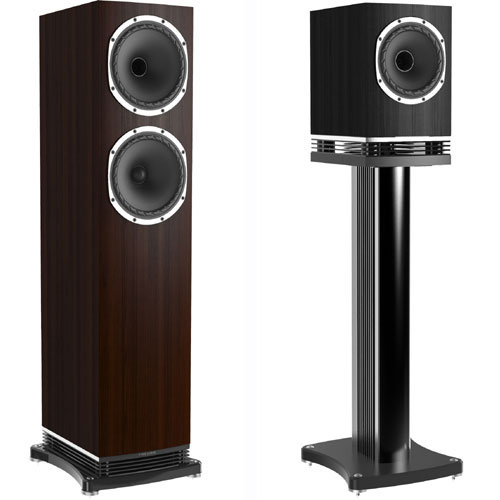Fyne Audio Loudspeakers: Something Old, Something New
Like many of the other venerable names in the UK audio industry, Tannoy has passed into new ownership. In 2015, the mainly pro-orientated Music Group acquired the Danish TC Group of companies. TC Group specializes in studio, broadcast and installed products, but had also acquired Tannoy in 2002. The takeover was largely focused on the home-studio and pro brands, meaning that Tannoy and, in particular, the much-loved (in certain, mainly Far East markets) Prestige series, with their big, dual-concentric drivers housed in ultra-traditional cabinetry, faced an uncertain future. With production of the other domestic ranges already moved to China, the Scottish workforce was dwindling and the rumors were swirling, leaving most of the existing management and production staff with a stark choice between jumping or being pushed. The end result was a highly experienced management team and personnel with no company to run. You can see where this is going. Much work, three product lines and one business plan later, the nascent Fyne Audio was able to attract significant external funding, and the company is up and running. As well as a fully ex-Tannoy masthead, the team includes members with experience at Mission and Wharfedale, and perhaps most notably, Dr Paul Mills, the man responsible for Tannoy product development for over 30-years. But don’t assume that Fyne Audio is simply manufacturing what amounts to rebadged Tannoy designs. Give a design team, tied to 30 years of product development, inherited culture and residual inventory, a blank sheet of paper and it’s like all of their birthdays arriving at once. No more using the existing parts (because there are so many in stock), no more sticking to given materials (because they’re synonymous with the brand), no more having to retain outmoded design features (because the customers still want them). This isn’t just an opportunity to revisit the design philosophy; it’s a chance to completely overhaul the thinking, materials, engineering and sourcing of every aspect of the product. These are point-source designs, conceived and manufactured in this century, rather than the last. The Fyne loudspeakers might have familiar DNA, but they’re a whole new ballgame, both sonically and aesthetically. The company showed examples from three ranges: the relatively conventional F300 series, which pairs multi-fiber paper cones with a 25mm soft-dome tweeter; the F500 series, based around 6" or 8" two-way coincident drivers; and the F1-10 flagship model, with its distinctive, curved-wall cabinet and periscope-style mounting for its 10" point-source driver. Of these, it’s inevitably the models with those coincident drivers that are going to attract all of the attention. Dubbed Isoflare by the company, these drivers are all-new designs, specially built for Fyne Audio to exacting specifications. A titanium-diaphragm compression driver is housed in the throat of the multi-fiber paper bass/midrange cone, with proprietary profiles for both the horn and cone flare. But that’s only the start of the story, with thoroughly modern thinking applied to everything from the cast baskets and fluted surrounds, to edge-wound voice coils and high-powered, vented motor configurations. Bass loading is reflex, but with a downward-firing port aimed at a flared 360-degree diffuser with a Tractrix profile. Placed at the bottom of the cabinet, this provides omnidirectional low-frequency output, but perhaps more importantly, the proximity to the floor maximizes bass weight and extension. Combine that with moderate sensitivities around the 90dB mark and gentle crossover slopes and you should get decent bandwidth and a driveable load. The heart of the range is the F500 series, ranging from £599 to £1599 per pair in price. The F500 (above right) is a compact stand-mount based on the 6" Isoflare coincident driver mounted in a conventional rectangular MDF cabinet. The single driver, narrower than it is deep, and all-around venting for the bass make for an unusual and attractive speaker. The F501 adds a 6" bass unit with a laminated paper cone to create a 2.5-way floorstander, while the F502 (above left) makes the move up to 8" drivers. Above that, the F1-10 uses a single 10" driver in its differentially ported, compressed plywood enclosure. One look at the picture should tell
you that these are not your dad’s Tannoys. Thoroughly modern in both thinking and
appearance, Fyne Audio’s products have stepped firmly away from the heritage branding
of the long-established Tannoy Prestige models, products that worked hard to look older
than they really were. In contrast, a speaker like the F502 wears its technological heart
very much on its aesthetically up-to-the-minute sleeve. At the same time, it makes an
acoustical-engineering argument for its point-source driver technology rather than a
traditionalist one. Whether that engineering philosophy can trump heritage appeal remains
to be seen -- and, internationally speaking, is probably market dependent -- but if the
impressive initial results from the speakers played in Bristol are anything to go by, it
sounds like Fyne Audio have succeeded in updating the two-way, point-source model without
diluting its original musical appeal. The products seen at the show were final
pre-production units, with initial production models expected within six to eight weeks,
definitely making Fyne Audio one to watch. |


